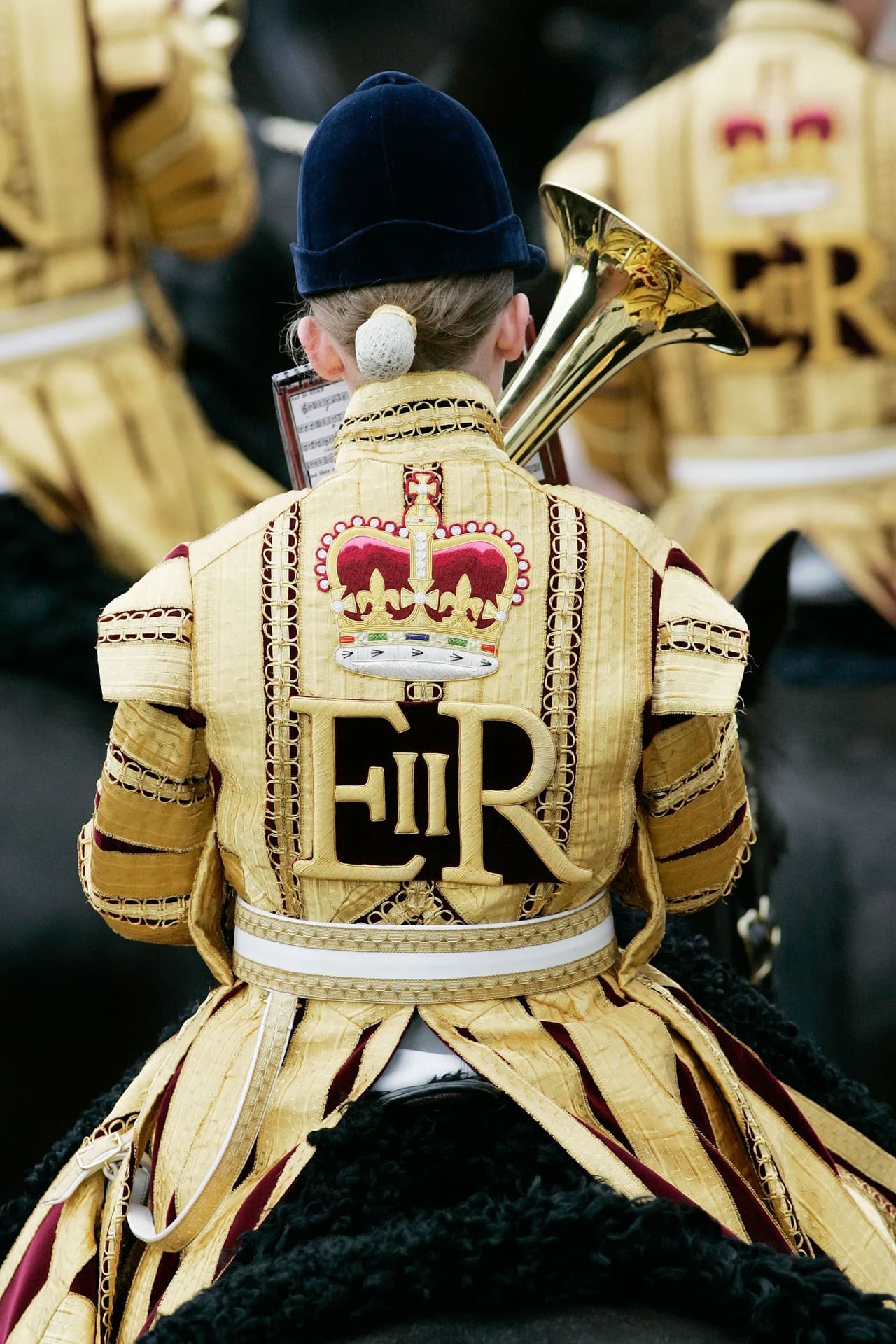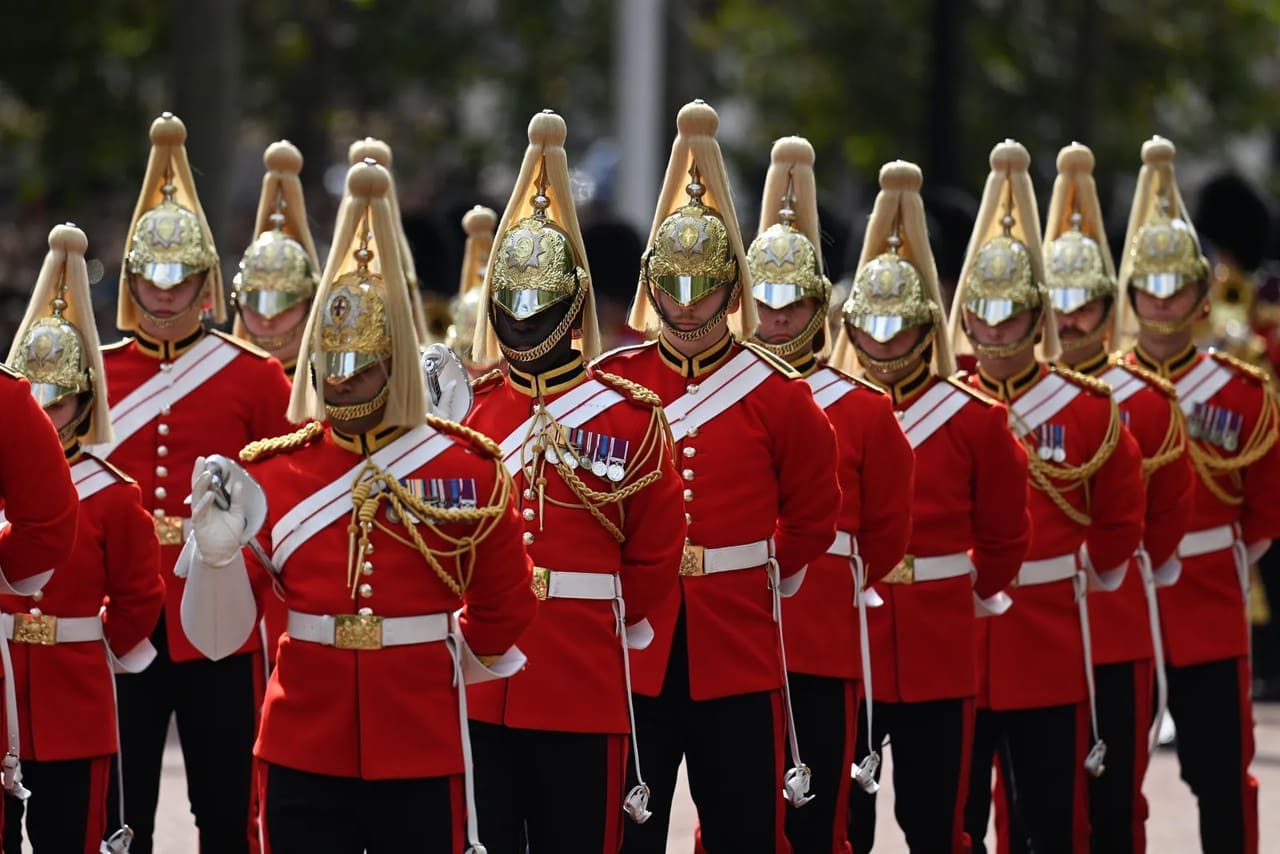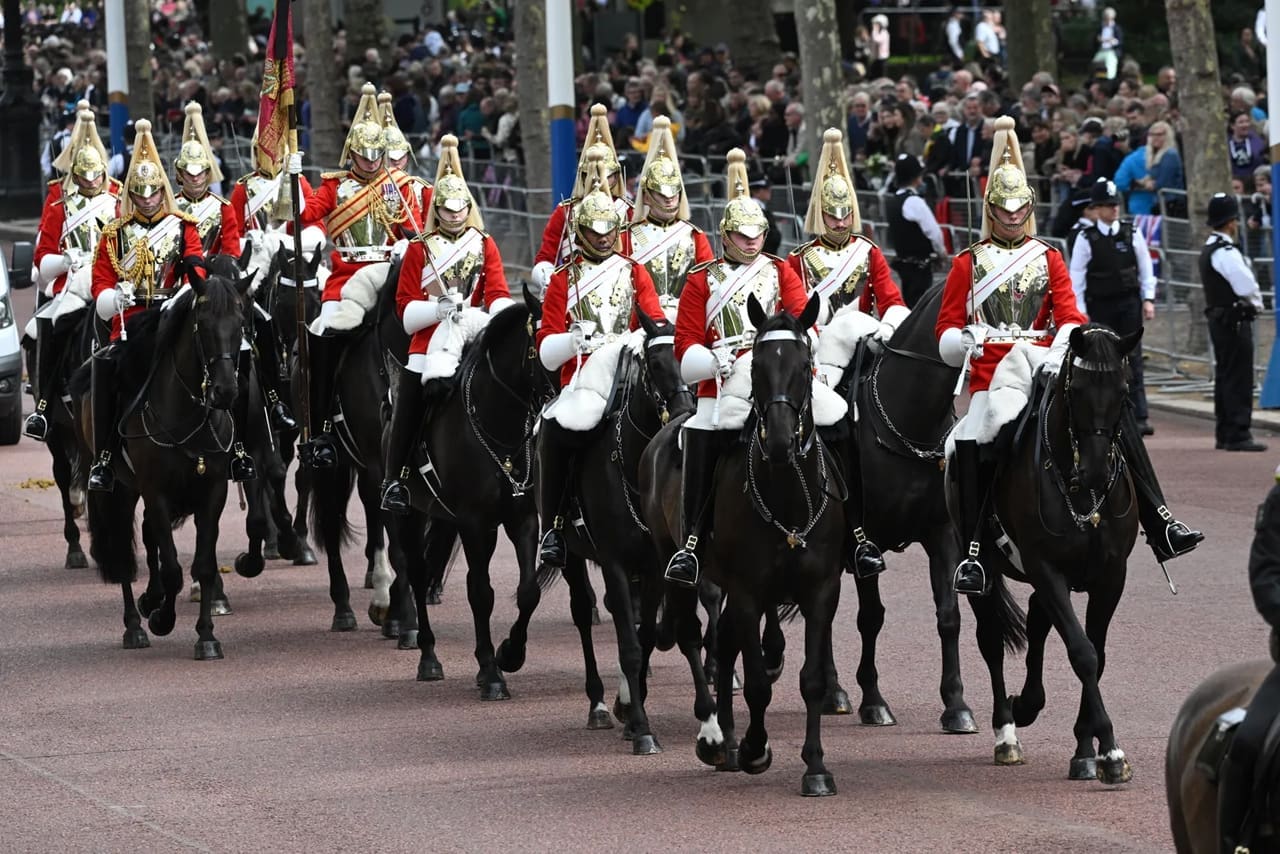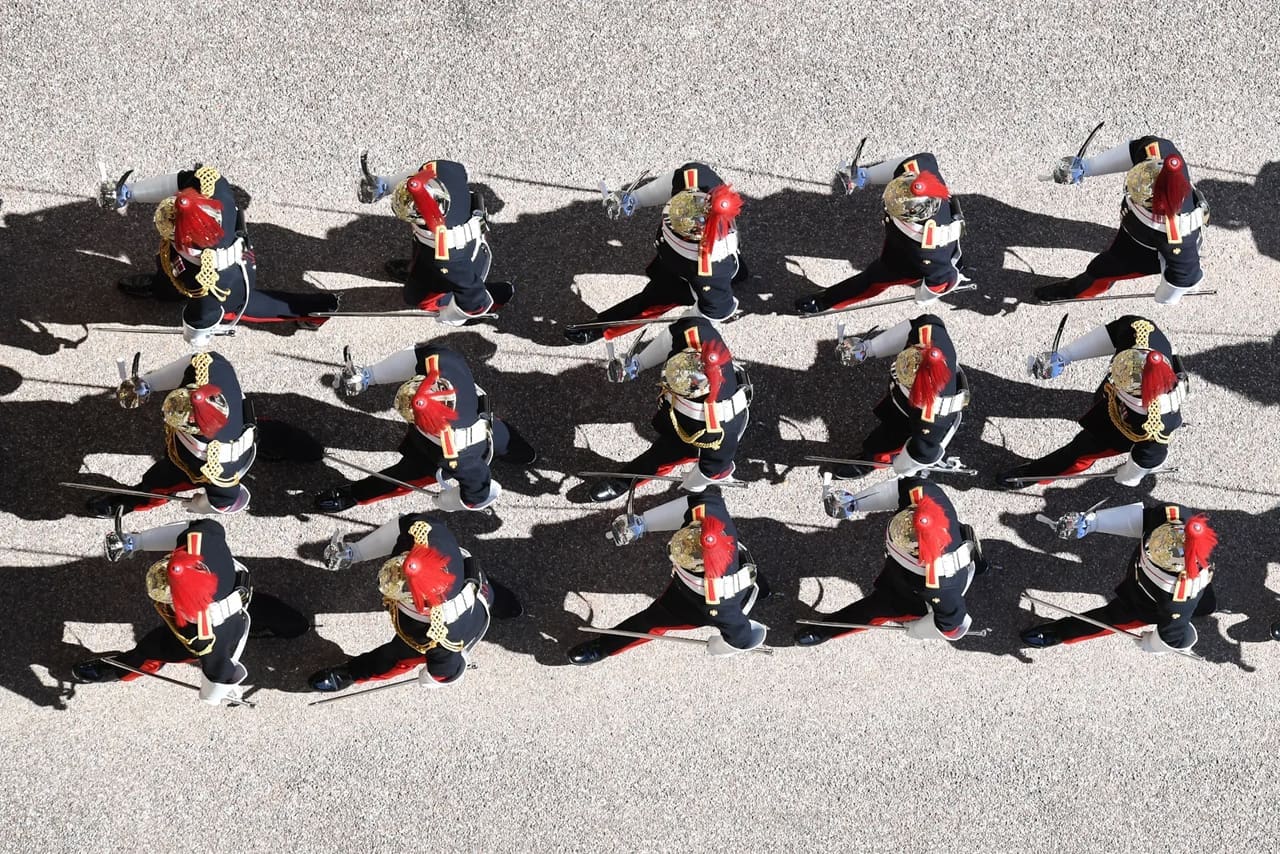Members of the Household Cavalry escort the coffin of Queen Elizabeth II. Photo: Getty Images
Members of the Household Cavalry escort the coffin of Queen Elizabeth II. Photo: Getty Images
The makers of the elaborate funeral dress for the parade at Queen Elizabeth II’s funeral will shine in plain sight on Monday.
Is it too frivolous to speak of the importance of how everything will look as the world watches the British pomp, ceremony, and religious ritual of Queen Elizabeth’s state funeral? Surely not. The Queen had overseen every detail of it herself, in a continuously reviewed plan codenamed Operation London Bridge, since at least the 1960s. Everyone who will be nervously getting dressed to play their solemn role tomorrow—be it the divisions of the Household Guard, Navy and Royal Air Force, Lord High Chamberlains, the Yeoman of the Guard, or the Archbishop of Canterbury and his clergy—will be feeling the personal weight of responsibility to go out looking impeccable.
As sovereign head of all the armed forces, Elizabeth’s close bond with the country’s military famously began in 1945, when she became the first female royal to join the Auxiliary Territorial Army. Whenever she visited the troops, everyone knew they were in for her laser-eyed once-over. “The Queen was known to be a stickler for dress,” remembers Christopher Joll, the Regimental Historian of the Household Cavalry. “She could spot a button upside down three ranks in.”

Unlike the perfunctory performance of a grandiose walk up and down—as in the style of Donald Trump, who crassly stepped ahead of the Queen at an inspection on his visit to Windsor Castle—“when Her Majesty inspected the troops, you really knew you were being inspected,” says Joll. Not that she didn’t bring a sense of fun to those occasions. Prince William has posted a favorite photograph of his grandmother making him blush and smile as he stood immaculately to attention in line at his officer’s passing-out parade at Sandhurst Royal Military in 2006. (The same for Harry.)

The constant coverage of the rituals of the final days of mourning has already hinted at the breathtaking presence of another, hidden British army that is taking part: skilled British companies of craftspeople who hand-make make every aspect of the vast panoply of uniforms, gleaming helmets, bearskins, plumes, and richly embroidered ceremonial garb. As somebody remarked over the past few days during London Fashion Week, not entirely facetiously: “There’s already been a military fashion week going on.”
In a stunning moment when the Queen’s coffin was carried into Westminster Hall, there was a glimpse of an item of court dress that is only ever worn by the six officers of the High Office of State: a red frock coat, its chest and torso entirely smothered in padded, 3-D gold embroidery of oak leaves. It was a piece dating back to Queen Victoria’s time, worn by the Duke of Norfolk, the Earl Marshal who is traditionally responsible for organizing the state funerals of sovereigns and the accession and coronation of new monarchs. He’s the ultimate man in charge of every detail of the arcane rules of heraldry. “Many of those uniforms are old and reworked,” remarks Stephen Jones. “Talk about sustainability!”

The preparations behind what will be “a world-class state ceremonial the like of which we have never seen in our lifetimes,” as the Major General who will be riding in the Household Cavalry puts it, have been going on for rather a long time. Centuries, in a way. The royal family has been awarding royal warrants to the makers of militaria and ceremonial accouterments since the 15th century. Among those prominently on duty will be the Life Guards, mounted in their distinctive red tunics, with 17-inch white plumes in their helmets. Their uniforms, tailored by Dege & Skinner of Savile Row, established in 1865, are a direct descendent of the ones which were worn to the Battle of Waterloo in 1815.

Christopher Joll described exactly what goes into the fitting of these full dress uniforms—not to mention the other eight different orders of dress that each officer is required to own upon graduating from Sandhurst. “The scarlet tunic, white buckskin breeches, the jackboots, the breastplate, sword, the gold lace—it takes at least six months to have it done,” he says. Back in the day, officers’ pride in achieving that slimness and sharpness of silhouette went as far as being fitted for corsets, he said. Asked if he’d agree that this astonishingly complex level of work is the British equivalent of the French haute couture industry, Joll said: “You’ve hit the nail on the head, there.”
A panoply of specialists lies behind the tailoring, frogging, gold epaulets, and feathers. The scarlet fabric of the ceremonial parade wear is Melton wool, made for over 200 years by the Hainsworth mill in Yorkshire using wool traceable back to the farm. The tribute to the Queen on their website shows her wearing one of their jackets, on horseback, at Trooping the Colour.

Then there’s a world of gold-bullion embroidery, which will be displayed all over the procession, in all its infinitely complex minutiae of symbolism. “It’s a highly exact, specialist art,” says Stephen Doig, who reports for The Telegraph on the ins and outs of military and men’s formal attire. “One piece of frogging slightly out of place can mean a whole different thing. It’s a minefield.”
Hand & Lock, founded in 1767, hold the Royal Warrant as “the world’s foremost heritage bespoke embroidery atelier.” Based at 86 Margaret St in London’s West End, they are responsible for the splendor of the gold embroidery, gold-work badges, laces, braids, cords, and monograms. The young production manager, Jessica Jane Powell, was interviewed on the BBC, saying that with “all of the Queen’s bodyguards’ uniforms it’s important to be involved with what they stand for. There are lots of things you have to adhere to, like sustainability—that’s a big part of what we strive to do. I think they invest in businesses that produce high quality and craftsmanship. That’s what we’re proud to do—championing embroidery and making sure the craft continues to go on.”
Goldings, based just outside of London in St Albans, are suppliers of the coats used by the trumpeters of the household cavalry—short jackets smothered in gold frogging—and over 50 regiments of the armed services, by appointment to the Queen. Many of the plumes and hackles for helmets, and caps will have been sourced from Jaffe et Fils, the long-established feather supplier based in the town of Axminster in the Somerset countryside. Much of the regalia of gleaming medals, decorations, and insignia, meanwhile, will be the work of the royal warrant holders Toye, Kenning & Spencer, a 10-generation business first established in Birmingham’s jewelry quarter in 1685. Edward Crutchley, the British designer and source of all knowledge on luxury fashion production, said backstage at his eponymous show: “The metalwork they do is incredible. I’ve used them often while working for Kim Jones in Paris.”

As for the high Anglican clergy who will officiate the Queen’s final rites, they too have their own haute couturiers. Tucked discreetly away in Tufton Street behind Westminster Abbey is Watts & Co, who amongst their rich wardrobe of vestments offer “bespoke full gothic chasubles,” costing £2736. Many of the precious garments, though, will be historic, like the extraordinary gilded Court Dress frock coat which has been handed down through the family of the Dukes of Norfolk. The work to preserve and restore such things—such as lifting centuries-old embroidery and invisibly replacing it on new fabric—is frequently carried out in the ateliers of the Royal School of Needlework in Henry VIII’s Hampton Court Palace.
Not that anyone would ever know it. The work of the countless people who have sewn, tailored, and fashioned the look of the pageantry, pomp, and ceremony of tomorrow’s historic farewell has been done according to the most profound British codes of discretion and secrecy. Tomorrow, they will finally be seen on parade, contributing the makers’ last duty to serving the Queen—their patron and customer for over 70 years.

This article originally appeared on Vogue.com
